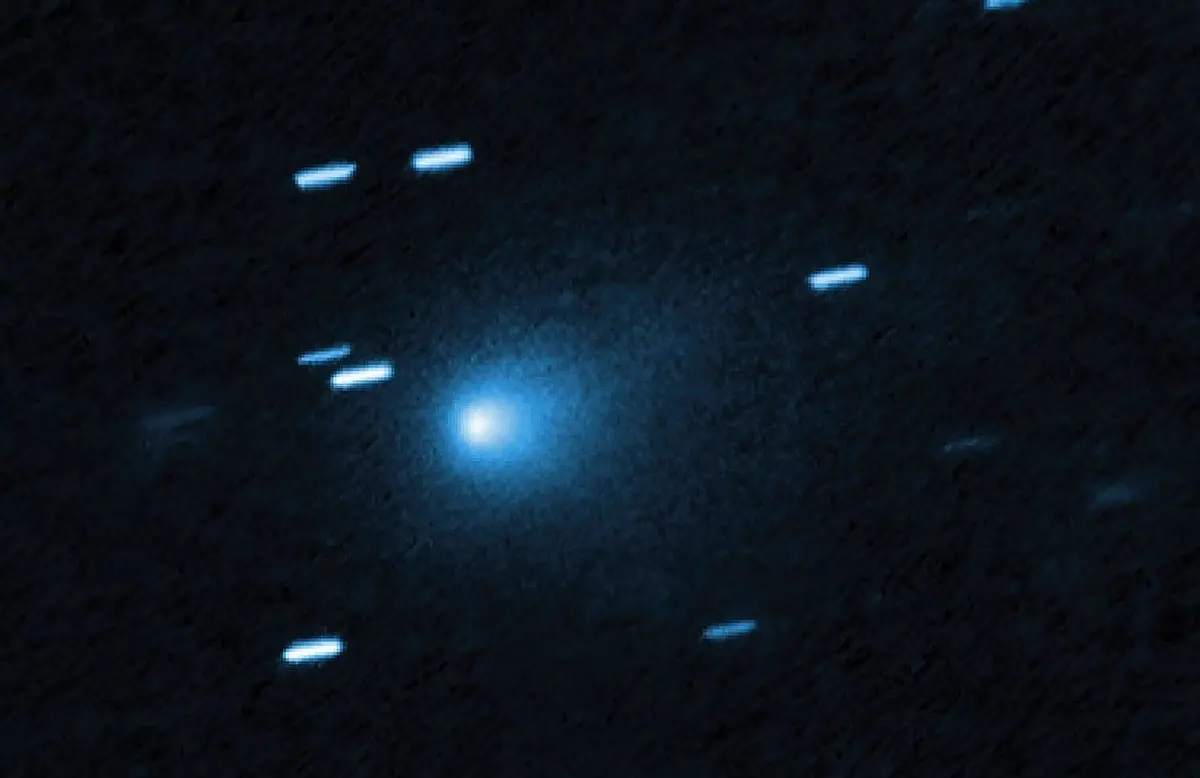Study evaluates the alignment of 3I/ATLAS closest approach with Jupiter’s Hill sphere
-
 Comet 3I/ATLAS (Image via NASA)
Comet 3I/ATLAS (Image via NASA)The interstellar object 3I/ATLAS is projected to reach its closest approach to Jupiter on March 16, 2026.
According to calculations by NASA’s JPL Horizons code, using orbital data collected from approximately 230 observatories, 3I/ATLAS will arrive at a minimum distance of 53.445 (+/- 0.06) million kilometers from Jupiter.
This value closely matches the Hill radius of Jupiter on the same date, which is 53.502 million kilometers, determined using the formula H=R*(m/3M)^{1/3}, where R is the Jupiter-Sun separation of 783.8 million kilometers, m is Jupiter’s mass, and M is the Sun’s mass.
The alignment between the closest approach distance and the Hill radius falls within one standard deviation. The measurement incorporates non-gravitational accelerations observed during 3I/ATLAS’s perihelion passage.
These calculations describe the gravitational interaction between 3I/ATLAS and Jupiter.
Calculation of Jupiter’s Hill radius
Jupiter’s Hill radius represents the region in which the planet’s gravity dominates over the Sun’s gravitational influence. The Lagrange points L1 and L2, located at the Hill radius, are positions where objects can maintain orbit with minimal orbital corrections and fuel requirements. Substituting the given values of R=783.8 million kilometers and (m/3M)^{1/3}=0.06826 into the Hill radius formula results in H=53.502 million kilometers. This calculation establishes the theoretical boundary for Jupiter’s gravitational influence during the time of 3I/ATLAS’s closest approach, providing a reference for orbital dynamics analysis.
Minimum distance of 3I/ATLAS from Jupiter
The minimum distance of 3I/ATLAS to Jupiter, Min{D}=53.445 (+/- 0.06) million kilometers, was determined by NASA’s JPL Horizons code, which incorporates non-gravitational accelerations measured during perihelion. The acceleration of 5x10^{-7} au per day squared, recorded over a month-long perihelion passage, altered the predicted closest distance by approximately 0.1 million kilometers. This correction brought the minimum distance to near equivalence with Jupiter’s Hill radius. Steve Fairfax noted the near coincidence of these values in communication with Harvard Professor Avi Loeb.
Implications for orbital dynamics
The proximity of Min{D} to the Hill radius has implications for potential capture of objects within Jupiter’s gravitational influence. Any satellites or debris released at this distance would require velocities sufficient to overcome Jupiter’s escape speed at the Hill radius, which is 2.2 kilometers per second. The relative speed of 3I/ATLAS with respect to Jupiter at closest approach is 65.9 kilometers per second, as indicated by orbital models. Objects deployed near this distance would need propulsion adjustments to remain bound to Jupiter. Observations from spacecraft such as Juno could detect any new orbiters that remain after the passage of 3I/ATLAS.
Statistical context and anomalies
The alignment of Min{D} and H represents a statistical coincidence. The margin of 0.06 million kilometers corresponds to one part in 1,000 relative to the Hill radius and one part in 26,000 relative to the full diameter of Jupiter’s orbit around the Sun. This calculation is included in the list of major anomalies of 3I/ATLAS as outlined by Harvard Professor Avi Loeb, along with other properties such as its nucleus mass, trajectory, and observed jets, which have been documented in recent observational reports.
The study of 3I/ATLAS’s approach provides a precise dataset for evaluating interactions with Jupiter’s gravitational domain. The near-match of the minimum distance to the Hill radius is confirmed by current measurements and calculations, forming a basis for further monitoring of the object’s trajectory and potential detection of any new material influenced by Jupiter’s gravity.
Stay tuned for more updates.
TOPICS: 3I/ATLAS, 3I/ATLAS comet, 3i/ATLAS recent updates, Avi Loeb 3I/ATLAS, comet 3I/ATLAS NASA update
- New model adjustments affect projected perijove distance for 3I/ATLAS
- Researchers update the route of 3I/ATLAS with support from ExoMars Trace Gas Orbiter
- 3I/Atlas’ journey becomes clearer thanks to Mars Orbiter observations, say astronomers
- Harvard astrophysicist suggests 3I/Atlas may be on a mission to observe Jupiter in bold new theory